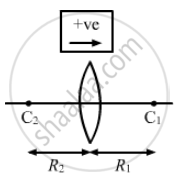Advertisements
Advertisements
Question
A double convex lens has focal length 25 cm. The radius of curvature of one of the surfaces is double of the other. Find the radii, if the refractive index of the material of the lens is 1.5.
Solution
Given,
Double convex lens of focal length, f = 25 cm
Refractive index of the material, μ = 1.5
As per the question, the radius of curvature of one surface is twice that of the other.
i.e. R1= R and R2= −2R
(according to sign conventions)
Using the lens maker formula
\[\frac{1}{f} = (\mu - 1)\left[ \frac{1}{R_1} - \frac{1}{R_2} \right]\]' we have:
\[\frac{1}{25} = \left( 1 . 5 - 1 \right)\left[ \frac{1}{R} - \left( \frac{1}{- 2R} \right) \right]\]
\[\Rightarrow \frac{1}{25} = 0 . 5\left[ \frac{3R}{2} \right]\]
\[ \Rightarrow \frac{1}{25} = \left[ \frac{3R}{4} \right]\]
\[ \Rightarrow R = 18 . 75 \text{ cm }\]
R1 = 18.75 cm and R2 = 37.5 cm
Hence, the required radii of the double convex lens are 18.75 cm and 37.5 cm.
APPEARS IN
RELATED QUESTIONS
What does sign of power (+ve or –ve) indicate?
(a) At what distance should the lens be held from the figure in order to view the squares distinctly with the maximum possible magnifying power?
(b) What is the magnification in this case?
(c) Is the magnification equal to the magnifying power in this case? Explain.

You have two lenses A and B of focal lengths +10 cm and –10 cm, respectively. State the nature and power of each lens. Which of the two lenses will form a virtual and magnified image of an object placed 8 cm from the lens? Draw a ray diagram to justify your answer
Kavita from 10th is using spectacles. The power of the lenses in her spectacles is –2.5 dioptre. Answer the following questions:
1) Which lenses are used in her spectacles?
2) State the defect of vision Kavita is suffering from.
3) Find the focal length of the lenses used in her spectacles
What is the power of a convex lens lens whose focal length is 80 cm?
A diverging lens has focal length of 3 cm. Calculate the power.
A convex lens of focal length 25 cm and a concave lens of focal length 10 cm are placed in close contact with one another.
(a) What is the power of this combination?
(b) What is the focal length of this combination?
(c) Is this combination converging or diverging?
Two lenses A and B have focal lengths of +20 cm and, −10 cm, respectively.
(a) What is the nature of lens A and lens B?
(b) What is the power of lens A and lens B?
(c) What is the power of combination if lenses A and B are held close together?
A combination of lenses for a camera contains two converging lenses of focal lengths 20 cm and 40 cm and a diverging lens of focal length 50 cm. Find the power and focal length of the combination.A optical instrument in which the above arrangement of convex lens is used is a convex lens used to burn paper by focusing sunlight.
A diverging lens has a focal length of 0.10 m. The power of this lens will be:
How is the power of a lens related to its focal length?
How is the sign (+ or -) of power of a lens related to its divergent or convergent action?
Consider the situation described in the previous problem. Where should a point source be placed on the principal axis so that the two images form at the same place?
A lens forms an upright and diminished image of an object, irrespective of its position. What kind of lens is this? Draw an outline ray diagram to show the formation of the image. State the position and one more characteristic of the image.
A convex lens is of focal length 20 cm. Find its power.
According to Rayleigh’s scattering law, the amount of scattering of light is inversely proportional to the fourth power of its ______.
The power of lens depends on the focal length of the lens
The focal length of a double convex lens is equal to the radius of curvature of either surface. What is the refractive index of its material?
